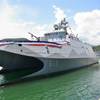The Australian government announced its acquisition strategy for the Future Submarine Program, setting out further details of the competitive evaluation process to be undertaken by the nation’s Department of Defense.
The government said it seeks the best possible capability and value for money for Australian taxpayers while maximizing the involvement of Australian industry. The process outlined today provides a pathway for Australian industry to maximize its involvement in the program, without compromising capability, cost, program schedule or risk, the government said.
As part of its plan, the government expects that significant work to be undertaken in Australia during the build phase of the future submarine including combat system integration, design assurance and land based testing. This will result in the creation at least 500 new high-skill jobs in Australia, the majority of which will be based in South Australia.
Additionally, the submarine must be delivered in time to avoid a capability gap in the mid-2020s when the Collins Class submarine is scheduled to be retired from service. The government’s decisions on the Future Submarine Program will determine what kind of capability we have to defend Australia and Australian interests into the 2040s and beyond.
Submarines are the most complex, sensitive and expensive defense capability acquisition a government can make. The Future Submarine Program is the largest defense procurement program in Australia’s history and represents an investment in the order of $50 billion in Australia’s security. These costs will be subject to refinement through the competitive evaluation process. A significant proportion of this investment will be spent in Australia during the lifetime of the future submarine.
As part of this competitive evaluation process, the Department of Defense will seek proposals from potential partners for pre-concept designs based on meeting Australian capability criteria; options for design and build overseas, in Australia, and/or a hybrid approach; rough order of magnitude (ROM) costs and schedule for each option; and positions on key commercial issues, for example intellectual property rights and the ability to use and disclose technical data.
In addition to this – and on the advice of defense – the government has endorsed a set of key strategic requirements for our future submarines, including range and endurance similar to the Collins Class submarine; sensor performance and stealth characteristics that are superior to the Collins Class submarine; and the combat system and heavyweight torpedo jointly developed between the United States and Australia as the preferred combat system and main armament.
Defense advises that for Australian industry to have the best opportunity to maximize its involvement in the Future Submarine Program, it needs to work with an international partner. Based on work completed by defense, France, Germany and Japan have emerged as potential international partners. All three countries have proven submarine design and build capabilities and are currently producing submarines. France, Germany and Japan will be invited to participate in this competitive evaluation process that will assess their ability to partner with Australia to develop a Future Submarine that meets our capability requirements.
The competitive evaluation process will help the government balance important considerations including capability, cost, schedule and risk. Interoperability with the country’s alliance partner, the United States, will also be a fundamental consideration.
An expert advisory panel will also be appointed to oversee the competitive evaluation process, expected to last around 10 months, after which an international partner will be selected for Australia’s Future Submarine Program.













